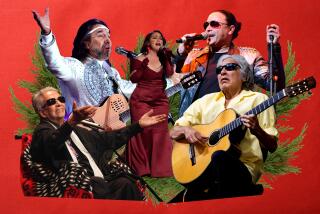MUSIC REVIEW : I Cantori Christmas Program
- Share via
Christmas choral entertainments generally tend to chestnuts roasted by a hopeful choir. Ever-imaginative conductor Edward Cansino took a different tack in the Old World-New World Baroque program his group, I Cantori, offered Sunday afternoon at Holliston United Methodist Church in Pasadena.
Heinrich Schutz’s Christmas Story--a.k.a. “Historia, der freuden und gnadenreichen Geburth Gottes und Marien Sohnes, Jesu Christi”--is a swiftly paced, colorful oratorio more honored in textbooks than performances. Cansino made an ample case for the neglected glories of the work, in a stylish, balanced reading.
Cansino also cast the very challenging solo parts wisely. The narrative was projected with ringing clarity and sensitivity by tenor Nmon Ford-Livene. His expressive range encompassed both the chromatic, sequential weeping over the slaughter of the innocents and the prophetic fervor of his final declarations, and all nuances between.
The bulk of the aria duties are assigned to an Angel, in this case Brian Asawa. Counter-tenors are no longer the hothouse, early music rarity they were a generation ago. Asawa, for pertinent example, is a Metropolitan Opera Auditions winner and was recently in the San Francisco Opera cast for the U.S. premiere of Henze’s “Das Verratene Meer.”
He has astonishingly even vocal production, and strength as well as purity. He delivered Schutz’s evocative, graceful writing with convincing, clarion joy.
Bass Kenneth Knight sang Herod’s aria with well-focused sound and dramatic point, and anchored the ensembles of wise men and priests. The chamber chorus sang brightly, and the small band of period instruments supplied much individual flair and virtuosity. Now if only they could have agreed on tuning and temperment . . . .
High contrast was provided by five early 17th-Century colonial villancicos . Cansino reinforced the metrical gamesmanship of Gaspar Fernandes’ “Eso rigor e repente” and Juan Gutierrez de Padilla’s “Las estrellas se rien” with the emphatic drumming of Timm Boatman. He elicited mostly flexible, buoyant singing in varied textures, including seductive modal inflections in Fernandes’ “Pois con tanta graca” from an occasionally timid solo sextet.
Mediating between the stately joy of the oratorio and the earthy glee of the villancicos was the Magnificat Quarti Toni by Francisco Lopez Capillas. The singers gave it a full measure of smooth, polyphonic dignity and rich sound.
More to Read
The biggest entertainment stories
Get our big stories about Hollywood, film, television, music, arts, culture and more right in your inbox as soon as they publish.
You may occasionally receive promotional content from the Los Angeles Times.










